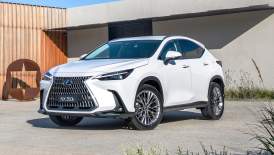
Honda ZR-V 2024 review: VTi LX long-term | Part 3
7.9/10
We are positively swimming with powertrain options at the moment, aren't we? You've got your petrol and diesel cars, of course. And we're pretty familiar with them. But then you've got conventional hybrids (think Toyota RAV4), plug-in hybrids (think Mitsubishi Outlander), e-Power hybrid (think the Nissan X-Trail), 48-volt mild hybrids (think the Jaguar F-Pace) and full BEVs (think the BYD Atto 3 or Tesla Model Y).The result of all this rampant electrification means not only are we all spoiled for choice, but the humble petrol-powered engine has become a little old hat in the face of newer, shinier rivals.But I'm here to mount a case for the old-school, having just spent three months behind the wheel of the top-spec petrol-powered Honda ZR-V VTi LX, which lists at $48,500 drive-away. And that's not chump change, but it's not the most expensive model in Honda's ZR-V family.[read-more-default-title]Honda ZR-V 2024 review: VTi LX long-term | Part 1Honda ZR-V 2024 review: VTi LX long-term | Part 2More than an electric car concept! Honda's 2026 brand reboot to start with retro Saloon and Space Hub vanNo, that honour is reserved for the hybrid version of the VTi LX, which is yours on the road for $54,900. Now, at $6400, that's a big jump. Especially given the equipment list is near identical. What you do gain with the hybrid, however, is a clever 2.0-litre electrified powertrain which doesn't just increase power (slightly) and torque (significantly), but also reduces your fuel use, down from a claimed 7.2L/100km to 5.0L/100km. So that’s just over two litres of fuel saved every hundred kilometres — or, at current prices, about $4 in petrol. Like most journalists, mathematics is my ultimate weak point, but by my calculations, you’d need to travel around 160,000kms to break even with the extra $6400 attached to the sticker price.Yes, you’ll cover those kinds of kays eventually. According to Budget Direct, the average Australian travels 12,100 kilometres per year. So — and this is math again, unfortunately — the average driver would take a smidge over 13 years to break even.This is not me having crack at the Honda hybrid, or any hybrid, by the way. There are many non-financial reasons to want to lower your fuel use — not least among them being that we don’t leave a world burning like an out-of-control tyre fire to those who come after us — but I’m just saying, if you can’t stretch to $50k-plus for your Honda, don’t stress too much.After all, I’ve found the power on offer from the 1.5-litre turbo-petrol engine (131kW and 240Nm) ample around town, even if I don’t love the CVT automatic, and the straining feeling it can produce on the freeway quite so much.In the city, though, the ZR-V is punchy and engaging, offering a just-right level of zip for urban manoeuvres, and doing it in a way that’s mostly quiet and refined, with little in the way of road noise entering the cabin.Electrification or no, the powertrain in our petrol-only ZR-V feels perfectly suited to the nature of Honda’s new mid-sizer.There is one sizeable flaw in my fuel argument, though, and that is that I actually haven’t gotten that close to the claimed fuel figure. My mix of city and freeway driving has produced real-world results of more like 8.9L/100km. But to save you the pain of me attempting maths again, I’ll add the caveat that, as I haven’t driven the hybrid model, I don’t know how close to its 5.0L/100km it gets either, so maybe the gap isn’t that different after all.The other perk of ZR-V ownership, though, is its size. This is actually among the smallest offerings in the mid-size SUV field, but I actually think that’s a positive, rather than a negative.The ZR-V stretches 4568mm in length, 1840mm in width and 1620mm in height. The Toyota RAV4, for example, is 4600mm, 1855mm and 1685mm respectively. But to be honest, I don’t think you’ll miss those extra millimetres when it comes to carrying passengers.The space in the back was ample for my 175cm frame, as it was for any and all passengers I carried over the past three months, and while the 370 litres (VDA) of luggage room with all seats in place won’t set the world alight, it does grow to a far more useable 1302 litres with each row folded. I’ve used the Honda as something of a moving van during my time with it, and I haven’t struggled at all.The downsides remain: it can be noisy and not overly motivated on the freeway, the ride might be too firm for some who prefer magic-carpet comfort, the wireless charging pad is all but useless for anyone using a newer iPhone, and the seats-up boot space is underwhelming up against its rivals.But the simple reality is that the good massively outweighs the bad here, and I still reckon the ZR-V continues Honda’s return to form of late. Acquired: February 2024Distance travelled this month: 930kmOdometer: 8932kmAverage fuel consumption this month: 8.9L/100km



















.png)






















































































































 copy.png)
















.png)






















.jpg)
.jpg)


.jpg)
.jpg)
